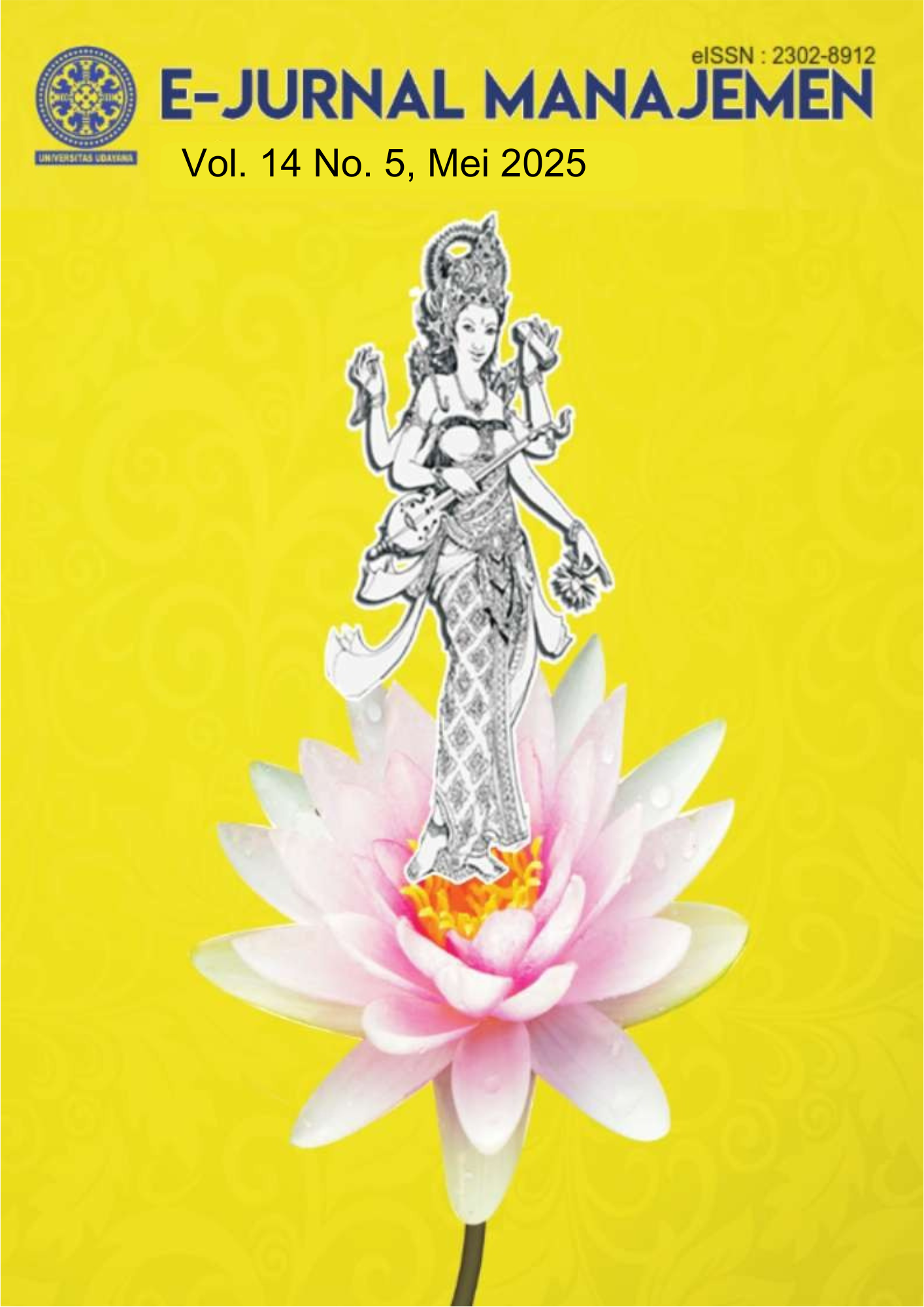EKSPLORASI INTERAKSI PEMASARAN MULTISENSORI DAN ARSITEKTUR LOKAL TERHADAP PENGALAMAN KONSUMEN
Abstract
Pemasaran multisensori memainkan peran penting dalam membentuk pengalaman dan keputusan konsumen dengan memanfaatkan elemen sensorik seperti visual, pendengaran, penciuman, pengecapan, dan sentuhan. Dalam konteks pariwisata dan bisnis, strategi ini semakin relevan ketika dikombinasikan dengan desain arsitektur lokal yang mencerminkan identitas budaya suatu destinasi. Penelitian ini bertujuan untuk mengeksplorasi keterkaitan antara pemasaran multisensori dan desain arsitektur lokal dalam meningkatkan pengalaman wisatawan serta loyalitas mereka terhadap destinasi tertentu. Metode penelitian yang digunakan dalam penelitian ini adalah menggunakan metode systematic literature review (SLR). Melalui tinjauan literatur pada artikel yang relevan secara mendalam, penelitian ini mengidentifikasi bahwa integrasi elemen multisensori dalam desain arsitektur lokal dapat memperkuat keterikatan emosional konsumen terhadap suatu tempat atau merek, meningkatkan daya tarik kunjungan dan meningkatkan pengalaman positif konsumen. Hasil penelitian ini menunjukkan bahwa pengalaman yang melibatkan berbagai aspek sensorik dapat menciptakan pengalaman yang lebih mendalam dan berkesan. Selain itu, ditemukan bahwa arsitektur dengan elemen sensorik yang kuat, seperti penggunaan material alami, pencahayaan, aroma khas, serta tata suara yang harmonis, mampu meningkatkan persepsi kualitas dan keaslian destinasi. Implikasi praktis dari penelitian ini adalah perlunya pelaku industri dan pengembang properti untuk mengadopsi pendekatan pemasaran multisensori dalam merancang arsitektur perusahaan yang autentik dan menarik.
Multisensory marketing plays a crucial role in shaping consumer experiences and decision- making by utilizing sensory elements such as visual, auditory, olfactory, gustatory, and tactile stimuli. In the context of tourism and business, this strategy becomes increasingly relevant when combined with local architectural design that reflects the cultural identity of a destination. This study aims to explore the relationship between multisensory marketing and local architectural design in enhancing tourist experiences and their loyalty to specific destinations. The research employs a systematic literature review (SLR) method, analyzing relevant academic articles in depth. The findings indicate that integrating multisensory elements into local architectural design can strengthen consumers’ emotional attachment to a place or brand, increase visit attractiveness, and enhance positive consumer experiences. Furthermore, it was found that architecture with strong sensory elements, such as the use of natural materials, lighting, distinctive scents, and harmonious sound arrangements, can improve the perceived quality and authenticity of a destination. The practical implications of this study emphasize the importance of industry players and property developers adopting a multisensory marketing approach in designing authentic and appealing corporate architecture to create memorable and immersive consumer experiences.
Downloads
References
Ahmadi, R. K., Purnomo, E. P., & Hadiyati, E. (2024). Integrating Marketing Strategy: Destination Image and Digital Marketing’s Impact on Tourist Interest in Banyuwangi. Matrik : Jurnal Manajemen, Strategi Bisnis Dan Kewirausahaan, 161. https://doi.org/10.24843/MATRIK:JMBK.2024.v18.i02.p06
Almaz, A., & ZEINA, A. (2023). The Perceived Interaction of Sensory Processing in Internal Space, Architectural Surrounds, and Endless Space. International Design Journal, 13(4), 331–338. https://doi.org/10.21608/idj.2023.305362
Aslaner, D. A. (2022). Dijital Çağda Tüketicinin Duyularına Hitap Etmek: Çoklu Duyusal Pazarlama Üzerine Bir Araştırma. Kahramanmaraş Sütçü İmam Üniversitesi Sosyal Bilimler Dergisi, 19(2), 698–722. https://doi.org/10.33437/ksusbd.1138427
Blahopoluchna, A. H., Shtangeeva, N. I., & Liakhovska, N. O. (2022). INFLUENCE OF AROMA MARKETING ON CONSUMER BEHAVIOR. Economies’ Horizons, 4(22), 4–11. https://doi.org/10.31499/2616-5236.4(22).2022.267012
Boucherit, S., Berkouk, D., Bouzir, T. A. K., Masullo, M., & Maffei, L. (2022). A Review of Inclusive Design and Multisensory Interactions Studies and Applications in Public Spaces. IOP Conference Series: Earth and Environmental Science, 1113(1). https://doi.org/10.1088/1755-1315/1113/1/012017
Cahyadi, I. (2019). Developing A Model with Dematel, Anp, Topsis Approaches for Marketing Strategy Selection in Batik Madura Industry. Matrik : Jurnal Manajemen, Strategi Bisnis Dan Kewirausahaan, 14(1), 20. https://doi.org/10.24843/matrik:jmbk.2020.v14.i01.p03
Eglīte, Ž. (2022). THE ROLE OF SENSES, EMOTIONS AND THE PRINCIPLES OF THE EXPERIENCE ECONOMY IN THE CREATIVE INDUSTRIES THE ROLE OF SENSES AND EMOTIONS IN THE CREATIVE INDUSTRIES. Culture Crossroads, 19. https://doi.org/10.55877/cc.vol19.25
Hamacher, K., & Buchkremer, R. (2022). Measuring Online Sensory Consumer Experience: Introducing the Online Sensory Marketing Index (OSMI) as a Structural Modeling Approach. Journal of Theoretical and Applied Electronic Commerce Research, 17(2), 751–772. https://doi.org/10.3390/jtaer17020039
Jiménez-Marín, G., Alvarado, M. del M. R., & González-Oñate, C. (2022). Application of Sensory Marketing Techniques at Marengo, a Small Sustainable Men’s Fashion Store in Spain: Based on the Hulten, Broweus and van Dijk Model. Sustainability (Switzerland), 14(19). https://doi.org/10.3390/su141912547
Kanchaikham, C., & Takagi, M. (2024). Frequent design concepts for conveying cultural identity toward accommodation architecture in Chiang Mai heritage district, Thailand. Journal of Asian Architecture and Building Engineering. https://doi.org/10.1080/13467581.2024.2373817
Kaushik S., & Gokhale N. (2022). Online Sensory Marketing: Developing Five-Dimensional Multi-Sensory Brand Experiences and its Effectiveness. CARDIOMETRY, 24, 567–576. https://doi.org/10.18137/cardiometry.2022.24.567576
Natalia, T. W. (2020). Pengaruh Konsep Lokalitas Terhadap Nilai Berbelanja Konsumen di Kota Bandung. Waca Cipta Ruang, 6(1), 25–33. https://doi.org/10.34010/wcr.v6i1.4195
Pramesti, D. S., Pitana, I. G., Paturusi, S. A., & Adikampana, I. M. (2023). Tourists’ Preferences for The Architectural Attractions in Bali. Environment-Behaviour Proceedings Journal, 8(26), 419–426. https://doi.org/10.21834/e-bpj.v8i26.5143
Puspa, O. :, Almas, A., & Wulandari, R. (2022). SUASANA SHOPPING CENTER DALAM MEMBANTU MENINGKATKAN PENGALAMAN RUANG BAGI DISABILITAS SENSORIK. https://doi.org/10.2241/narada.2022.v9.i1.009
Ramanankonenana, T. M., & Randriamamonjy, L. H. (2022). INTERNATIONAL JOURNAL OF ECONOMICS AND BUSINESS ISSUES Effect of sensory marketing in Consumer behavior during the Act of purchase: a case study of supermarkets.
Sagha, M. A., Seyyedamiri, N., Foroudi, P., & Akbari, M. (2022). The One Thing You Need to Change Is Emotions: The Effect of Multi-Sensory Marketing on Consumer Behavior. Sustainability (Switzerland), 14(4). https://doi.org/10.3390/su14042334
Shahid, S., Paul, J., Gilal, F. G., & Ansari, S. (2022). The role of sensory marketing and brand experience in building emotional attachment and brand loyalty in luxury retail stores. Psychology and Marketing, 39(7), 1398–1412. https://doi.org/10.1002/mar.21661
Silaban, P. H., Chen, W. K., Eunike, I. J., & Silalahi, A. D. K. (2023). Traditional restaurant managers’ use of sensory marketing to maintain customer satisfaction: Findings from PLS-SEM and fsQCA. Cogent Business and Management, 10(1). https://doi.org/10.1080/23311975.2023.2196788
Spence, C. (2020). Senses of place: architectural design for the multisensory mind. In Cognitive Research: Principles and Implications (Vol. 5, Issue 1). Springer Science and Business Media Deutschland GmbH. https://doi.org/10.1186/s41235-020-00243-4
Spence, C. (2022a). Experimental atmospherics: a multi-sensory perspective. Qualitative Market Research: An International Journal, 25(5), 662–673. https://doi.org/10.1108/QMR-04-2022-0070
Spence, C. (2022b). Sensehacking the guest’s multisensory hotel experience. In Frontiers in Psychology (Vol. 13). Frontiers Media S.A. https://doi.org/10.3389/fpsyg.2022.1014818
Thalib, S., Wulandjani, H., Nawasiah, N., Hendryadi, H., & Mais, R. G. (2023). Explaining Students Revisit Intention via Scarcity Cues and Perceived Value: the Role of Sensory Brand Experience as Boundary Condition. Matrik : Jurnal Manajemen, Strategi Bisnis Dan Kewirausahaan, 1. https://doi.org/10.24843/matrik:jmbk.2023.v17.i01.p01
Yasa, I. K. D., & Kusumadewi, N. M. W. (2024). PERAN KEPERCAYAAN MEMEDIASI PENGARUH CUSTOMER EXPERIENCE TERHADAP REPURCHASE INTENTION. E-Jurnal Manajemen Universitas Udayana, 13(2), 317. https://doi.org/10.24843/EJMUNUD.2024.v13.i02.p08
Yuan, Y., Liu, G., Dang, R., Lau, S. S. Y., & Qu, G. (2021). Architectural design and consumer experience: an investigation of shopping malls throughout the design process. Asia Pacific Journal of Marketing and Logistics, 33(9), 1934–1951. https://doi.org/10.1108/APJML-06-2020-0408
Yusuf, A. A., & Hadinugroho, D. L. (2024). Perancangan Shopping Center dengan Pendekatan Arsitektur Neo Vernakular di Kota Padangsidimpuan. Abstrak : Jurnal Kajian Ilmu Seni, Media Dan Desain, 1(4), 138–150. https://doi.org/10.62383/abstrak.v1i4.220
Zha, D., Foroudi, P., Melewar, T. C., & Jin, Z. (2024). Examining the Impact of Sensory Brand Experience on Brand Loyalty. Corporate Reputation Review. https://doi.org/10.1057/s41299-023-00175-x
Zhou, G., Chen, W., & Wu, Y. (2022). Research on the Effect of Authenticity on Revisit Intention in Heritage Tourism. Frontiers in Psychology, 13. https://doi.org/10.3389/fpsyg.2022.883380





















